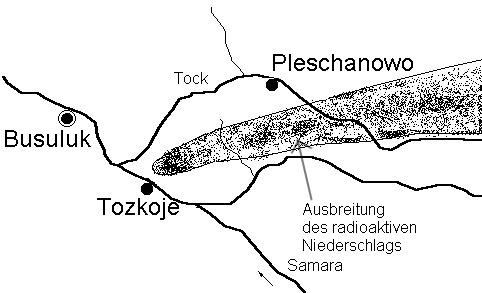



 |
 |
 |
 |
| Deutsche Version | Plautdietsche Version | By Dietrich Tissen and Nikolaj Tissen |
last modified January 21st, 2005 |
Nuclear Test in Totskoye in 1954
In 1954 a nuclear bomb test took place on the training area near Totskoye, the explosion location lay only 50-60 km away from Neu Samara. On the one hand, further experiences with atomic bomb tests should be collected, in addition, an army practise should be carried out at the same moment, to train the soldiers for a tactical nuclear attac. At that time the army has still imagined, that the atomic bombs could be used as a tactical weapon, like the artillery. After the occurred atomic bomb explosion the area should be taken by the soldiers. At that time the Americans have also carried out several tests of this kind.  The realization Altogether 45,000 soldiers from different army parts have taken part in the exercise. In addition there came another 600 tanks, 500 cannons and mine throwers, 320 airplanes and 6000 automobiles. As important personalities marshals G.K. Zhukov, A.M. Vasslevskij, K.K. Rokossovskiy, I.S. Konew observed the test, further there were the secretary general of the Communist Party 1953–64 Nikita Khrushchev, secretary of defense N.A. Bulganin and the nuclear scientist I.V. Kurtchatov present. The nuclear test area should be so selected, that it is similar to the prospective deployment place in Germany, i.e. it should be hilly, wooded landscape. The previous tests were mostly carried out in a desert area near Semipalatinsk (today Kazakhstan). After "careful" investigation the military training area in Totskoye has been selected. This was already used since the end of the 18th century as a military camp and field exercise area. After preparations of several days, about 380 km of protection ditches were dug, the exercise should take place on the 14th of September, 1954. Although there was in the beginning almost calm, the wind in northeast direction became stronger and stronger. However, it was still within the scope of the permissible as the carrier airplane started. At 9.00 o'clock the wind reached the speed of 20 m/s. At 9.33 o'clock the atomic bomb was thrown down from a height of 8,000 m and was detonated about 45 seconds later at a height of 350 m. The used atomic bomb had a power of 40 kilotons TNT (possibly 2-3 fold of the Hiroshima bomb). 5 minutes after the explosion the artillery and airplanes started to bomb the explosion place. Then after the demarcation of the radioactive zones, about 3 hours after the explosion, the soldiers marched on armoured vehicles from two sides, they should practice the taking of the hostile area after the atomic bomb explosion. The effects On a distance of 300 ms of the epicenter the ground completely burned out. Also in the other distance almost only stumps have been left from the trees. Within a radius of about 5 kms lying villages Makhovka, Olkhovka and Yelshanka burned out(the inhabitants were evacuated before). Almost all soldiers, who had taken part in the exercise, had to carry bad health effects. Many have died later of cancer. Those, which had gotten quite strong dose, died already in the military camp in Totskoye of the radiation sickness.  If one looks at it, on the map of the Neu Samara settlement, the in south and east lying villages must be mostly affected by the radioactive precipitation, so Kuterlja, Kaltan, Klinok, Jugowka, Klinok and Krassikowo. However, in the end all villages must have gotten some of it, because the radioactive dust was blown away later by the wind to other places also. An eyewitness from Kuterlja reports: all women of our village were occupied with the watermelon harvest on the field, suddenly the eyes were blinded by a bright light for one moment. A vague bang resounded and all women turn their eyes to the west. A big, black mushroom cloud rose up there, high up to the sky. "The atomic bomb, the atomic bomb!" all shouted in a mess. A strong wind blew sheets, branches, maps, scraps about the watermelon field. We marvelled all at the big miracle which eyewitnesses we were now. To a big oak leaf I wanted to chase after, at that time, because there were no oaks in our area. "Let this lie, we don't know what it is soiled with!" called Helene Schröder to me. I obeyed her advice.The high column disappeared bit by bit and we began to work again. (from "New Samara am Tock", "Kuterlja 1892-1992 - reminiscenses on selected deceased on the cemetery" by Katharina Nachtigal, nee Unger, abridged by me). One could hear and see the explosion still at a distance of about 50 km. The mention of the oak leaves is noteworthy also, at the explosion place there grew many oaks, the sheets must come from there. The health effects on the affected villagers have been never examined by the officials. However, one knows that many have fallen ill with cancer later. So the already mentioned Katharina Nachtigal writes also that many people from Kuterlja have died of cancer, possibly as a result of this nuclear test. In 1997 a book about the effects of the atomic bomb explosion in Totskoye on the environment and the people in the Orenburg Oblast (province) was published. The of the government independent authors have carried out an investigation with different methods in the beginning of the 90-s. They have ascertained a raised installment of cancer illnesses in the area affected by the radioactive precipitation. Further one can go out from a damage of the genotype, what will affect on the descendants. |